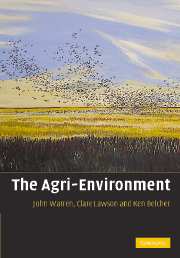Book contents
- Frontmatter
- Contents
- Preface and Acknowledgements
- 1 An introduction to agro-ecology
- 2 Agricultural support and environmentalism
- 3 Environmental impacts of agriculture
- 4 Principles behind agri-environment schemes
- 5 Farm conservation planning
- 6 Habitat management
- 7 The management of agricultural wastes
- 8 Low-impact farming systems
- 9 Landscape and farmscape ecology
- 10 The future of agri-environmental systems
- Glossary
- References
- Index
5 - Farm conservation planning
Published online by Cambridge University Press: 08 December 2009
- Frontmatter
- Contents
- Preface and Acknowledgements
- 1 An introduction to agro-ecology
- 2 Agricultural support and environmentalism
- 3 Environmental impacts of agriculture
- 4 Principles behind agri-environment schemes
- 5 Farm conservation planning
- 6 Habitat management
- 7 The management of agricultural wastes
- 8 Low-impact farming systems
- 9 Landscape and farmscape ecology
- 10 The future of agri-environmental systems
- Glossary
- References
- Index
Summary
Introduction
Although this is predominantly a science book, the art of producing a farm conservation plan requires an understanding of many diverse topics including social skills, economics, history, geography, hydrology, not to mention agriculture and conservation ecology. Needless to say, no one individual can be an expert in all these elements, so this chapter simply describes the main elements that are needed in producing a general farm conservation plan that would meet the requirements of a typical agri-environment scheme. Most Organisation for Economic Co-operation and Development (OECD) countries have developed farm conservation planning tools including Environmental Farm Plans in Canada and New Zealand, Conservation Planning initiatives in the United States, Farm Conservation Plans across Europe and Planning initiatives associated with the Land Care Program in Australia. While each conservation planning initiative is somewhat unique, all include general objectives of identifying environmental risks and conservation opportunities of the target farm. This chapter avoids covering in depth the quirks and foibles of any particular scheme, because although all schemes appear to have these idiosyncrasies and although they are of some interest and often highly amusing, they tend to be parochial and ephemeral. This chapter is designed as a practical guide, identifying and ordering the main elements that should be considered when producing a farm conservation plan with a particular focus on the UK context. Some of these aspects may be intuitively obvious, but many issues are easy to overlook unless you are a veteran of farm conservation planning.
- Type
- Chapter
- Information
- The Agri-Environment , pp. 83 - 104Publisher: Cambridge University PressPrint publication year: 2007



